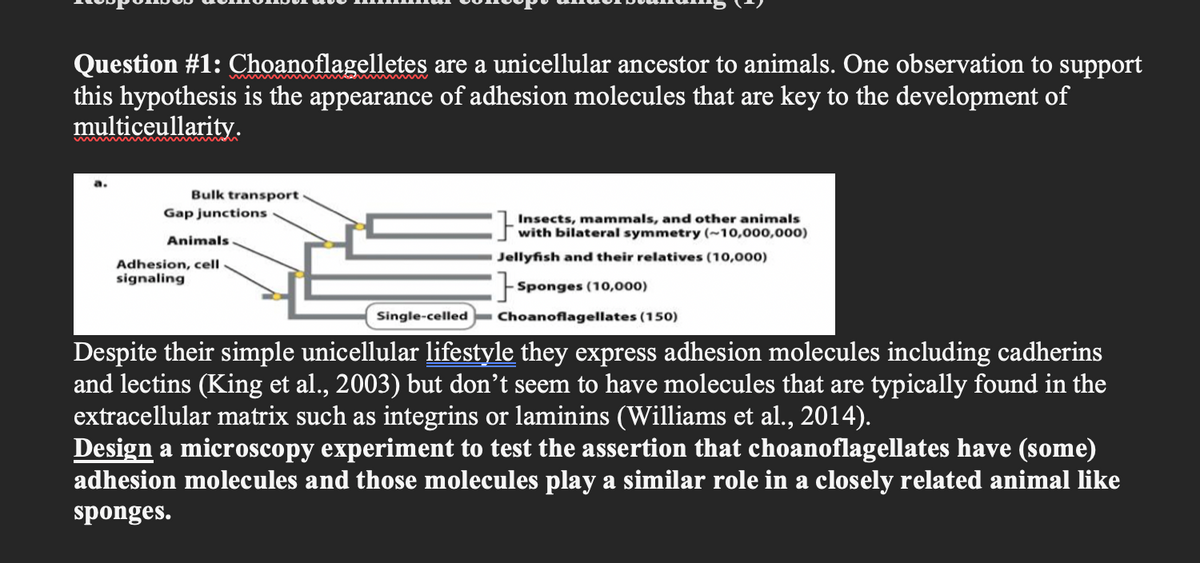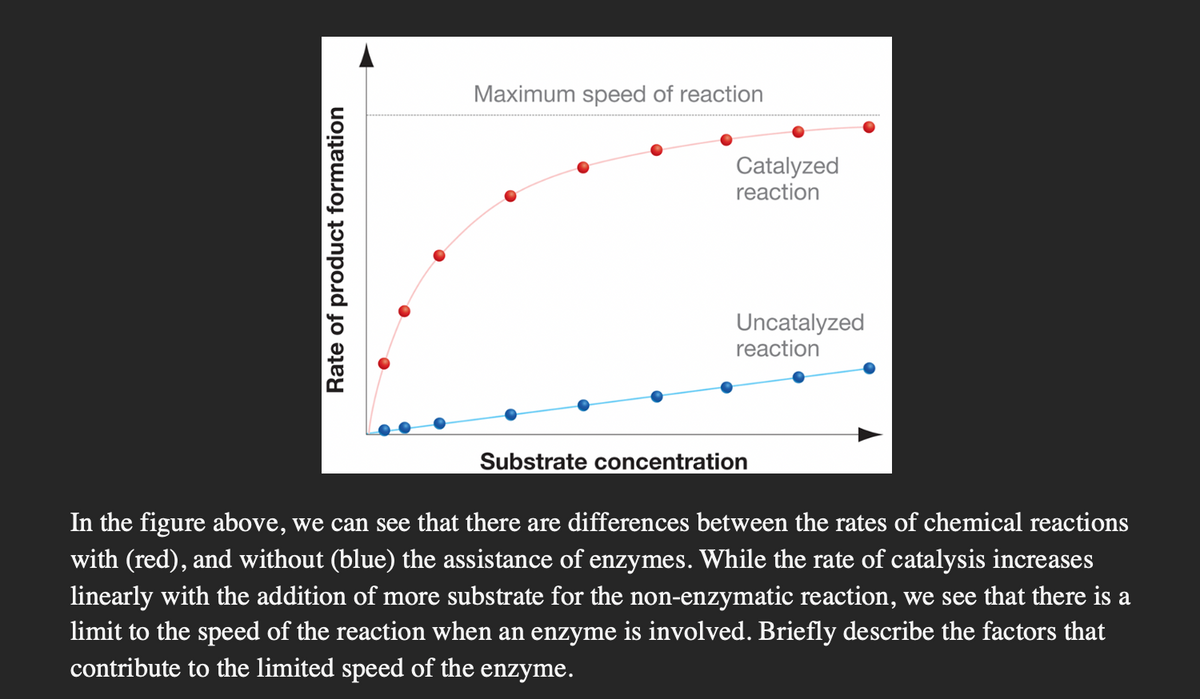Question #1: Choanoflagelletes are a unicellular ancestor to animals. One observation to support this hypothesis is the appearance of adhesion molecules that are key to the development of multiceullarity. Bulk transport- Gap junctions Insects, mammals, and other animals with bilateral symmetry (~10,000,000) Jellyfish and their relatives (10,000) Sponges (10,000) Choanoflagellates (150) Despite their simple unicellular lifestyle they express adhesion molecules including cadherins and lectins (King et al., 2003) but don't seem to have molecules that are typically found in the extracellular matrix such as integrins or laminins (Williams et al., 2014). Design a microscopy experiment to test the assertion that choanoflagellates have (some) adhesion molecules and those molecules play a similar role in a closely related animal like sponges. Animals Adhesion, cell. signaling Single-celled
Question #1: Choanoflagelletes are a unicellular ancestor to animals. One observation to support this hypothesis is the appearance of adhesion molecules that are key to the development of multiceullarity. Bulk transport- Gap junctions Insects, mammals, and other animals with bilateral symmetry (~10,000,000) Jellyfish and their relatives (10,000) Sponges (10,000) Choanoflagellates (150) Despite their simple unicellular lifestyle they express adhesion molecules including cadherins and lectins (King et al., 2003) but don't seem to have molecules that are typically found in the extracellular matrix such as integrins or laminins (Williams et al., 2014). Design a microscopy experiment to test the assertion that choanoflagellates have (some) adhesion molecules and those molecules play a similar role in a closely related animal like sponges. Animals Adhesion, cell. signaling Single-celled
Human Anatomy & Physiology (11th Edition)
11th Edition
ISBN:9780134580999
Author:Elaine N. Marieb, Katja N. Hoehn
Publisher:Elaine N. Marieb, Katja N. Hoehn
Chapter1: The Human Body: An Orientation
Section: Chapter Questions
Problem 1RQ: The correct sequence of levels forming the structural hierarchy is A. (a) organ, organ system,...
Related questions
Question

Transcribed Image Text:Question #1: Choanoflagelletes are a unicellular ancestor to animals. One observation to support
this hypothesis is the appearance of adhesion molecules that are key to the development of
multiceullarity.
Bulk transport
Gap junctions
Animals.
Adhesion, cell
signaling
Single-celled
:}
Insects, mammals, and other animals
with bilateral symmetry (~10,000,000)
Jellyfish and their relatives (10,000)
} Sponges (10,000)
Choanoflagellates (150)
Despite their simple unicellular lifestyle they express adhesion molecules including cadherins
and lectins (King et al., 2003) but don't seem to have molecules that are typically found in the
extracellular matrix such as integrins or laminins (Williams et al., 2014).
Design a microscopy experiment to test the assertion that choanoflagellates have (some)
adhesion molecules and those molecules play a similar role in a closely related animal like
sponges.

Transcribed Image Text:Rate of product formation
Maximum speed of reaction
Catalyzed
reaction
Uncatalyzed
reaction
Substrate concentration
In the figure above, we can see that there are differences between the rates of chemical reactions
with (red), and without (blue) the assistance of enzymes. While the rate of catalysis increases
linearly with the addition of more substrate for the non-enzymatic reaction, we see that there is a
limit to the speed of the reaction when an enzyme is involved. Briefly describe the factors that
contribute to the limited speed of the enzyme.
Expert Solution
This question has been solved!
Explore an expertly crafted, step-by-step solution for a thorough understanding of key concepts.
This is a popular solution!
Trending now
This is a popular solution!
Step by step
Solved in 3 steps

Knowledge Booster
Learn more about
Need a deep-dive on the concept behind this application? Look no further. Learn more about this topic, biology and related others by exploring similar questions and additional content below.Recommended textbooks for you

Human Anatomy & Physiology (11th Edition)
Biology
ISBN:
9780134580999
Author:
Elaine N. Marieb, Katja N. Hoehn
Publisher:
PEARSON

Biology 2e
Biology
ISBN:
9781947172517
Author:
Matthew Douglas, Jung Choi, Mary Ann Clark
Publisher:
OpenStax

Anatomy & Physiology
Biology
ISBN:
9781259398629
Author:
McKinley, Michael P., O'loughlin, Valerie Dean, Bidle, Theresa Stouter
Publisher:
Mcgraw Hill Education,

Human Anatomy & Physiology (11th Edition)
Biology
ISBN:
9780134580999
Author:
Elaine N. Marieb, Katja N. Hoehn
Publisher:
PEARSON

Biology 2e
Biology
ISBN:
9781947172517
Author:
Matthew Douglas, Jung Choi, Mary Ann Clark
Publisher:
OpenStax

Anatomy & Physiology
Biology
ISBN:
9781259398629
Author:
McKinley, Michael P., O'loughlin, Valerie Dean, Bidle, Theresa Stouter
Publisher:
Mcgraw Hill Education,

Molecular Biology of the Cell (Sixth Edition)
Biology
ISBN:
9780815344322
Author:
Bruce Alberts, Alexander D. Johnson, Julian Lewis, David Morgan, Martin Raff, Keith Roberts, Peter Walter
Publisher:
W. W. Norton & Company

Laboratory Manual For Human Anatomy & Physiology
Biology
ISBN:
9781260159363
Author:
Martin, Terry R., Prentice-craver, Cynthia
Publisher:
McGraw-Hill Publishing Co.

Inquiry Into Life (16th Edition)
Biology
ISBN:
9781260231700
Author:
Sylvia S. Mader, Michael Windelspecht
Publisher:
McGraw Hill Education